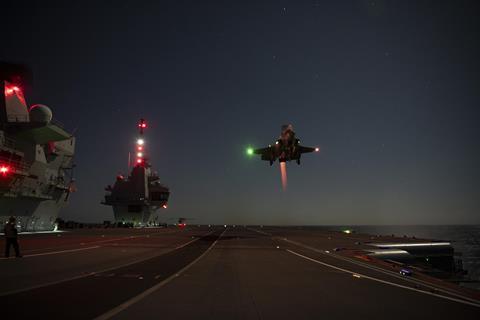Building upon a series of flight evaluations with the UK Royal Navy’s (RN’s) HMS Prince of Wales, test pilots with the US Marine Corps (USMC) have successfully completed a night-time rolling landing on to the UK’s newest aircraft carrier.
The 29 October flight was part of an ongoing effort to expand the operating envelope of the carrier air wing aboard Prince of Wales. The vessel is one of London’s Queen Elizabeth-class carriers, designed to operate the short take-off and vertical landing (STOVL) Lockheed Martin F-35B Lightning II.

The latest manoeuvre under the trials was a so-called shipborne rolling vertical landing (SRVL), undertaken at night. Completed on 29 October, the night SRVL follows a similar, day-time manoeuvre carried out on 20 October.
The rolling landing trials are meant to evaluate the ability of F-35Bs to return to ships while carrying heavier-than-typical payloads. “The landing technique could lead to tactics where a pilot returns to the ship with heavier loads, for example [with] more fuel or weapons,” the Pentagon says.
Standard vertical landings involve pilots approaching from the port side of carriers in vertical flight mode, then flying sideways over the deck, hovering over the landing spot and touching down.
The rolling landings involved F-35Bs descending in vertical flight mode from aft of the carrier while maintaining some forward momentum. The pilots completed short low-speed rolls after touching down to bleed momentum before braking.
The US Navy calls the flight trials “envelope expansion” of the operating parameters for both the F-35B and the UK’s aircraft carrier fleet.
“SRVLs are being looked at as an alternate way to land the STOVL jet,” the service says. “If assessed a viable technique, pilots could return to a ship and land with additional weight, for example more fuel or weapons, than permissible for a vertical landing.”
The RN launched the current Prince of Wales deployment on 1 September, with the goal of “pushing the limits of aircraft carrier operations”.
“My team are really excited to tackle the final phase of testing which will expand the F-35’s awesome capabilities even more,” said RN Commander Martin Russell, commander of the air group and flight deck operations aboard Prince of Wales, said at the time.
The carrier trials, which are taking place off the eastern seaboard of the USA, include test flights with the F-35B, Bell-Boeing MV-22 Osprey tiltrotor, a Sikorsky CH-53K heavy-lift helicopter and the first use of uncrewed aerial vehicles to deliver supplies to a RN carrier at sea.
While the F-35B has been flying with the RN for the past five years, the service says “there’s still more to learn” about the fifth-generation stealth fighter.
“HMS Prince of Wales will also be looking to launch and land the Lightning jets in the heaviest sea states, proving that they can operate the jets in the harshest environments,” the navy says.
In addition to the SRVL tests, the UK sailors and American aviators also completed a so-called “beast mode” launch of an F-35B from Prince of Wales. That manoeuvre involved a specially modified Lightning II carrying an ultra-heavy load of weapons.
The F-35’s standard weapons load is 6,800kg (15,000lb), according to Lockheed. However, under the special beast mode configuration, maxed-out F-35Bs can carry 9,980kg of payload – roughly three times more than the UK’s final Harrier GR9 variant, the service says.
The Queen Elizabeth-class carriers are equipped with a flightdeck measuring 280m (918ft) long and 70m wide, according to the RN.
The two vessels can each carry a standard air wing of up to 36 F-35Bs and four Leonardo Helicopters AW101 Merlin rotorcraft, but can be configured to carry additional fighters based on specific mission needs.


























